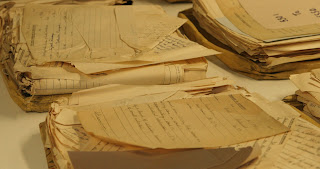An ongoing task has been the re-housing of LHSA’s collection of glass plate negatives which relate to the teaching of Obstetrics at Edinburgh University
The plates were originally stored in individual envelopes in wooden chests of drawers, which put them at a high risk of being damaged either from scraping against each other or being trapped at the back of a drawer. The paper the envelopes are made from is acidic and will corrode film emulsion over time. Additionally the chests are very heavy and awkward to move, again risking harm to the plates and injury to staff.
 |
| Glass plate negatives before re-housing |
Re-housing is carried out as follows: the plates are accurately measured and sleeves cut from Photon paper to fit them exactly. Each plate is assigned a reference number and all information from the original envelope is transferred to the sleeve. The plates are then put into 4 flap folders in sets of 4 and placed upright in archive standard cardboard boxes. The size of the boxes has been chosen so that when full they can be comfortably lifted.
 |
| Glass plate negatives after re-housing |
As a result of this re-housing, the plates are protected from damage and take up less space in the stores.




